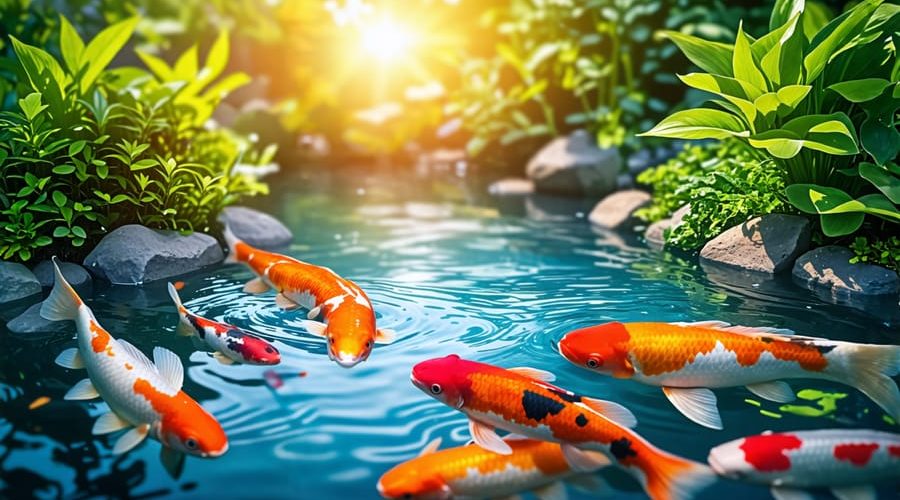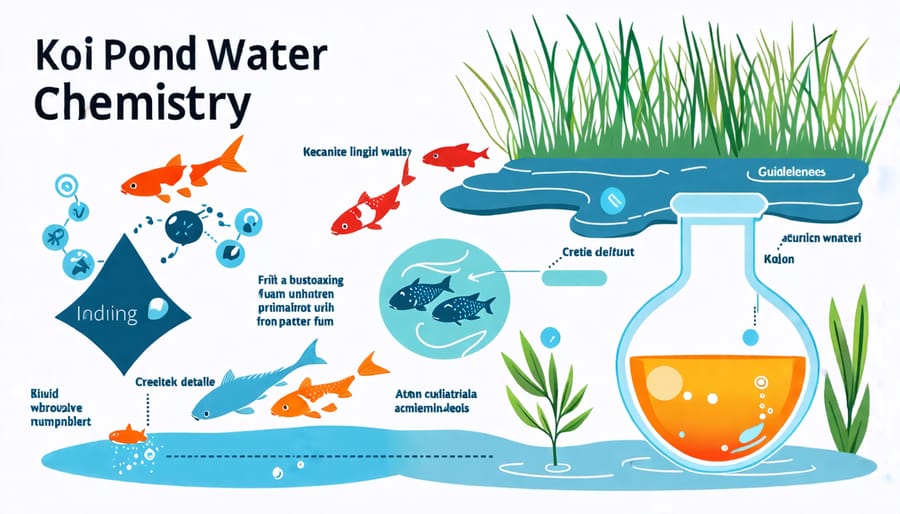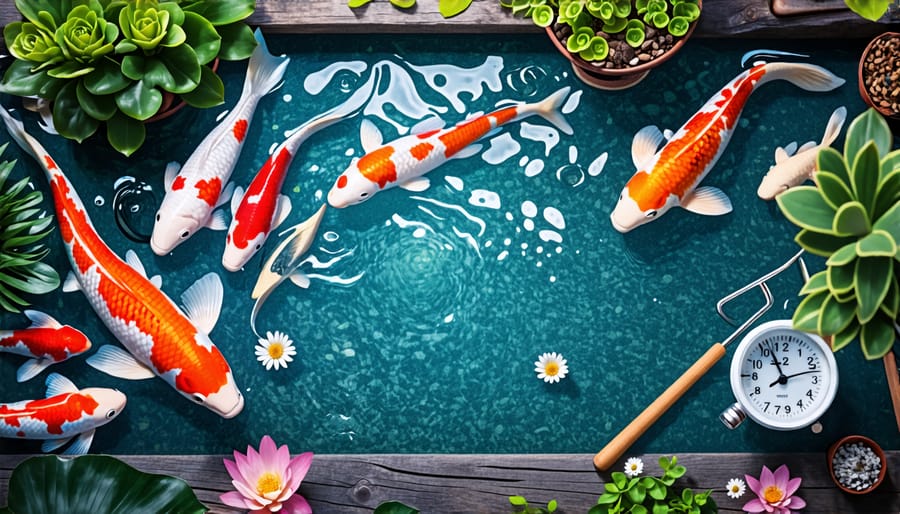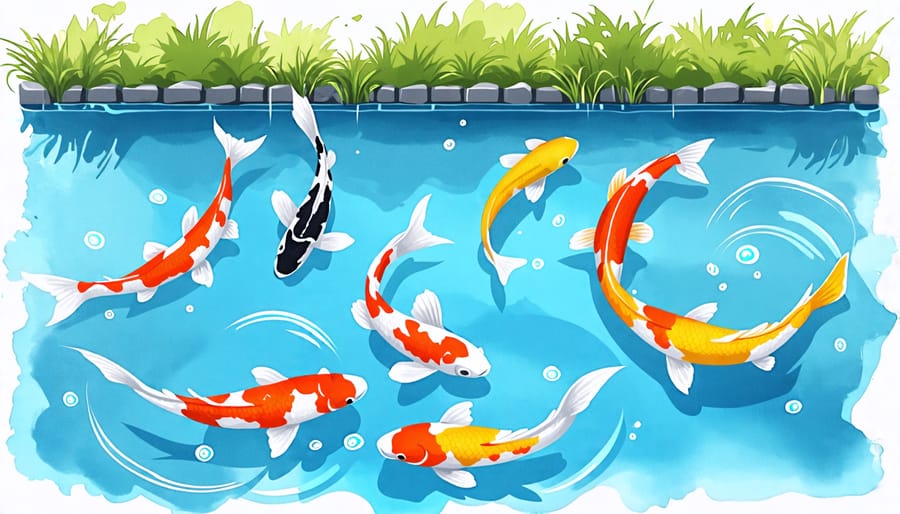
Unlock the Secrets to Crystal Clear Koi Pond Water with Easy Testing
Test the water pH level regularly, maintaining it between 7.0 and 8.0 for optimal koi health. Utilize a reliable test kit for ammonia, nitrite, and nitrate, keeping their levels at zero to prevent fish stress or disease. Examine pond filters monthly, cleaning them to ensure clear water and efficient mechanical and biological filtration. Implement regular pond maintenance, including pump maintenance tips, to support consistent water flow and oxygenation.
Understanding Koi Pond Water Elements

The Basic Water Chemistry
Understanding basic water chemistry is key to keeping your koi pond healthy and beautiful. Let’s start with pH, which measures the acidity or alkalinity of water. Ideally, a koi pond’s pH should be between 7 and 8. Above or below this can stress your koi, leading to health issues. Regular testing helps maintain balance and ensures a stress-free environment for your fish.
Next is ammonia, produced from fish waste and decaying organic matter. Even low levels can be harmful, causing damage to gills and increasing stress. It’s crucial to test frequently and ensure your pond’s biofilter is functioning effectively to break down ammonia into less harmful substances.
Moving on to nitrites, which are a byproduct of ammonia breakdown. Although less harmful than ammonia, elevated levels can still affect fish health by interfering with oxygen transport in koi’s blood. Regular water changes and a healthy biofilter can help keep nitrite levels in check.
Finally, nitrates are the end product of the nitrogen cycle and are less toxic, but high concentrations can encourage unwanted algae. Routine testing and periodic water replacements help maintain nitrate levels, ensuring your koi thrive in a clean, balanced living space.
Hardness and Alkalinity
Understanding the hardness and alkalinity of your koi pond is crucial for maintaining a healthy environment for your finned friends. Hardness refers to the presence of minerals like calcium and magnesium in the water, which helps to stabilize the pH and provide essential nutrients for koi health. Alkalinity, on the other hand, measures the water’s ability to neutralize acids and also plays a vital role in keeping pH levels consistent. Both are important as they work together to prevent sudden fluctuations that can stress your koi and potentially lead to health issues. Regular testing ensures your pond water remains balanced, providing a safe haven for your koi to thrive.
Temperature Considerations
Temperature plays a crucial role in maintaining koi pond water quality. As temperatures fluctuate with the seasons, so do water parameters, impacting the health and happiness of your koi. Warmer waters, for instance, may decrease oxygen levels and speed up metabolism, necessitating more food and oxygen. Conversely, colder temperatures slow everything down, requiring less food and prompting koi to conserve energy. Keep a close eye on your water’s temperature using a reliable pond thermometer. Adjust your maintenance routine to match the seasonal changes, ensuring your pond remains a thriving habitat for your beloved koi.
Step-by-Step Guide to Testing Your Koi Pond Water
Gathering the Right Tools
To ensure your koi pond stays a vibrant, healthy oasis, gathering the right tools for water testing is essential. First on the list is a high-quality water test kit, which checks key parameters like pH, ammonia, nitrites, and nitrates—vital indicators of water quality. Look for kits with clearly marked vials and easy-to-read color charts to simplify the process. A digital pH meter is also handy for more precise readings. Don’t forget gloves to protect your hands during testing. Additionally, have a notebook or digital app ready to log results, helping you spot trends and prevent issues before they arise.

Performing the Tests
Testing the water in your koi pond is crucial to keep your fish healthy and your pond looking its best. Here’s a step-by-step guide to help you perform these tests effectively, whether you’re a beginner or a seasoned pond enthusiast.
Start by gathering your testing materials, which typically include test kits for parameters like pH, ammonia, nitrite, and nitrate. You can find these kits in most garden or pet stores. For best results, test your pond water weekly.
Begin with a pH test, which indicates the acidity or alkalinity of the water. Ideal pH levels for a koi pond are between 7.0 and 8.6. To test, fill the test tube with pond water up to the indicated line, add the pH test solution, and cap it. Shake gently, then wait a few minutes for the color to develop. Compare the color to the chart provided in your kit to determine the pH level.
Next, test for ammonia which can be harmful to koi even at low levels. Follow a similar procedure as with the pH test, using the ammonia test solution and comparing the resulting color with your kit’s chart. Pay attention to ensure the ammonia level is close to zero.
After ammonia, check the nitrite levels; these should also be nearly zero as high levels can stress the fish. Nitrate levels, though less harmful, should remain under control as well, ideally below 40 ppm. Both tests follow similar steps to the pH and ammonia tests.
Remember, each kit might have slight variations in directions, so always refer to the instructions specific to your kit. Happy testing, and enjoy the beauty of your healthy koi pond!
Interpreting the Results
Understanding your koi pond water test results is easier than you might think. Each test reveals important clues about water quality, helping you maintain a healthy environment for your fish. If pH levels are too high or low, it could stress your koi; aim for a range of 7 to 8. Nitrate and ammonia levels should be minimal, indicating that your pond’s filtration system is effective. High readings demand immediate action, like water changes or improved filtration. Regular testing will reveal trends over time, allowing you to make adjustments before issues arise, ensuring your pond remains a vibrant, serene retreat.

Creating a Testing Routine
Establishing a consistent testing routine is essential for maintaining optimal water quality in your koi pond, ensuring fish health and visual clarity. Start by setting a regular schedule, ideally testing your water weekly. To make this routine stick, choose a time that easily fits into your schedule—like a weekend morning—and mark it on your calendar as a non-negotiable appointment with your pond. Regularity is key; even a small delay can allow water quality to dip below ideal levels, affecting your pond’s ecosystem.
Each testing session should measure key parameters, including pH, ammonia, nitrite, nitrate, and KH (carbonate hardness), which are vital to the well-being of your koi and other aquatic life. For the beginners, test kits offer a straightforward way to get accurate readings without needing a chemistry background. These kits usually come with handy color charts to help you interpret results at a glance.
To make the process more engaging, try keeping a dedicated pond journal. Jot down your weekly readings and any changes you make, like adjusting feeding amounts or cleaning filters. Over time, this log becomes an invaluable resource, helping you recognize patterns and fine-tune your care routine. Remember, a little routine testing goes a long way in keeping your pond pristine and your koi happy.
Troubleshooting Common Water Quality Issues
Addressing pH Fluctuations
pH fluctuations in a koi pond can be unsettling, but with a few simple steps, you can manage and stabilize them effectively. Start by testing your water regularly with a reliable pH test kit. Aim for a stable pH level between 7.0 and 8.0. If levels drop or rise unexpectedly, consider adding crushed oyster shells to your filtration system or using limestone rock in your pond. Both are natural buffers that help maintain a balanced pH. Remember to change about 10-20% of the water weekly to prevent harmful buildup of substances that could disturb the pH balance. Consistency is key to a thriving pond environment.
Dealing with Ammonia Spikes
If you notice ammonia spikes in your koi pond, immediate action is essential to protect your fish. Start by doing a partial water change of about 25-30% to dilute the ammonia levels. Stop feeding your koi temporarily as decomposing food can worsen the situation. Consider enhancing your pond’s external filtration systems to improve water quality consistently. You can also introduce beneficial bacteria that help to break down ammonia naturally. Regularly monitor your water parameters to ensure a healthy environment for your koi.
Reducing Nitrites and Nitrates
Maintaining a healthy koi pond hinges on managing nitrites and nitrates effectively. Start by adding more aquatic plants; they naturally absorb these compounds, improving water quality. Regularly clean your pond to remove debris and excess fish waste, which contribute to higher levels. Consider installing a biological filter to promote beneficial bacteria that convert harmful nitrites into less toxic substances. Don’t forget to perform partial water changes, swapping out about 10-15% weekly to keep levels in check. Your fish will thank you!
Conclusion
In wrapping up our exploration of maintaining a beautiful koi pond, the significance of regular water testing cannot be overstated. Water quality is the backbone of any thriving pond ecosystem. By routinely checking for key factors like pH levels, ammonia, nitrite, and nitrate, you safeguard the health of your koi and the aesthetic appeal of your pond. Consistent monitoring allows you to catch any imbalances early, preventing potential hazards to your fish and avoiding costly remedies down the line. For anyone who cherishes their outdoor space, ensuring pristine water by staying vigilant with water tests ensures that your pond remains a peaceful sanctuary for koi and a delightful focal point for your garden. Whether you’re new to water gardening or a seasoned enthusiast, embracing this aspect of pond care helps you cultivate a vibrant, healthy habitat that rewards your dedication with tranquility and beauty.
